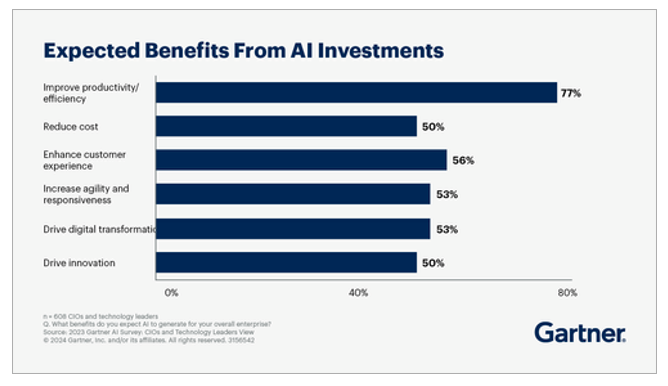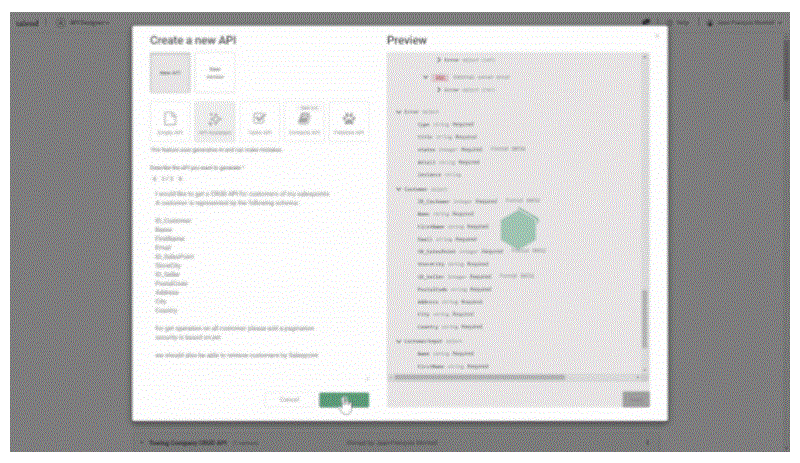
As part of the continued evolution of Qlik Talend Cloud, a powerful new feature has been introduced to help accelerate and standardize API contract creation.
You can now use a built-in AI assistant in the graphical API designer to generate complex API contracts—simply by describing the desired behavior in natural language. This AI-driven creation method offers a faster, more intuitive way to build and iterate on your APIs, especially during early design phases.
This enhancement makes it easier than ever to go from ideation to implementation while ensuring consistency and best practices across your API landscape.
In 2024, the number of AI related APIs grew an incredible 807%. APIs unlock data, providing a consistent platform for sharing and collaboration. According to Gartner, there is a measurable 36% increase in productivity when using AI-assisted development portals, as they lower technical barriers and accelerate time to deployment. In an ever-expanding data landscape, in-demand API creation skills are urgently needed to support critical development roles.
The Evolution of API creation
Nearly seven years ago, Talend introduced the API Designer, enabling enterprise users to build powerful APIs for use in Talend Studio workflows. Its graphical interface simplified API contract creation and allowed users to do the following actions:
- Creating API endpoint paths and underlying resources to route data to the required processes
- Specifying operations such as POST, GET, PUT, or DELETE
- Declaring specific data types
- Generating reusable API components such as query parameters
- Adding markdown and comments to document the API
- Using sectional formatting to reduce complexity and group related functionality
These APIs can be implemented directly in Talend Studio using a dedicated Studio component. Each endpoint connects to a powerful processing pipeline, allowing developers full control to search, transform, and manipulate datasets. Existing Studio jobs can be incorporated into these processes, promoting code reuse and ensuring consistent business logic across the enterprise.
APIs can also be seamlessly exported to your preferred API gateway. Versioning is centrally managed to ensure compliance with stringent CI/CD processes.
The API feature set evolved with the addition of the API Tester, allowing developers to open APIs in a test environment early in the design process. Users can run the Studio job tied to the API contract, open a request, and test real-time responses using sample data in the request body.
Finally, live documentation was added to complete the collaboration loop—making it easy to share fully documented APIs with the development team in a single click.
Using Generative AI and Prompt Engineering
Prompt engineering has become a vital part of enterprise application UI, allowing users to interact seamlessly with AI models to accelerate development. By embedding structured prompts into workflows, businesses can enhance automation, improve decision-making, and streamline complex tasks.
These systems offer contextual suggestions, reduce errors, and boost productivity. Developers benefit from faster code generation, optimized queries, and AI-assisted debugging, while non-technical users can access advanced functionality without deep coding skills. The result is a more intuitive, efficient user experience—where AI enhances creativity, speeds delivery, and empowers teams to focus on innovation.
Creating complex APIs can be time-consuming and detailed. The benefits of prompt engineering become immediately apparent by accelerating early-stage development and providing a foundation for refinement. GenAI’s ability to interpret and translate written instructions into contextual actions has proven pivotal across the platform.
The AI Assistant for API Designer
By integrating prompt engineering into the API Designer, developers can input an overview of their desired structure and receive AI-driven suggestions for optimized API endpoints. This new feature complements the existing graphical interface, and APIs created via prompt can still be updated using the graphical editor.
For Qlik Talend Cloud users, this results in faster API creation, a reduced learning curve, and enhanced usability. Developers can quickly generate sample requests and structured responses, cutting development time and minimizing inconsistencies in API design.
Conversational prompts can also reveal new API features that developers may not have initially considered—making the process more accessible to non-technical users and fostering innovation.
API Creation Walkthrough
The AI Assistant process is remarkably straightforward. When creating a new API, instead of jumping directly into the graphical interface, select the AI Assistant as the build option.
From there, simply write a brief description of your API, and a boilerplate contract is automatically created. You can preview and incrementally refine the structure—validating each step, and adding specific instructions like schema definitions or pagination.
Once satisfied with your API design, you simply save your API, then either review in the graphical API Designer, or implement your unit tests in API Tester.
The Qlik team believes that bringing customized AI experiences to Qlik Talend Cloud is essential. These tools help reduce user workload and accelerate consistent, reliable outcomes. API creation has traditionally been a complex, high-skill process. With the AI Assistant for API Designer, the barrier is lower, making data access easier, faster, and more accessible.
For more information, click here for full documentation on the AI Assistant.
For information about Qlik™, click here: qlik.com.
For specific and specialized solutions from QQinfo, click here: QQsolutions.
In order to be in touch with the latest news in the field, unique solutions explained, but also with our personal perspectives regarding the world of management, data and analytics, click here: QQblog !




